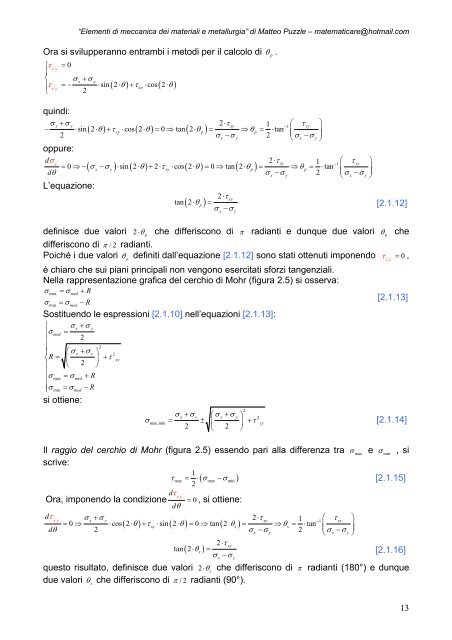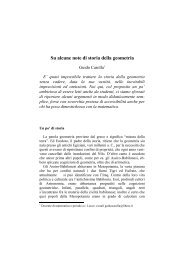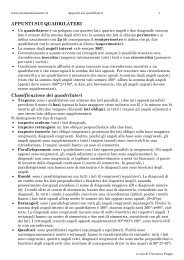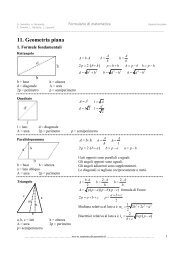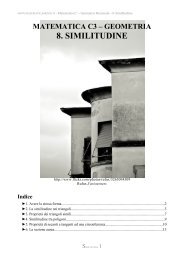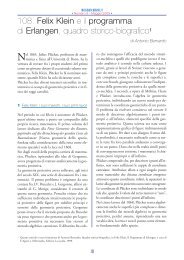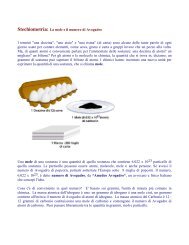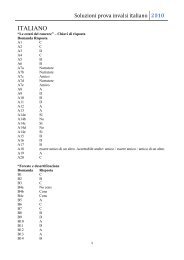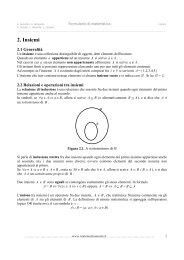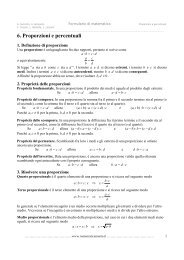Elementi di meccanica dei materiali e metallurgia - Matematicamente.it
Elementi di meccanica dei materiali e metallurgia - Matematicamente.it
Elementi di meccanica dei materiali e metallurgia - Matematicamente.it
Create successful ePaper yourself
Turn your PDF publications into a flip-book with our unique Google optimized e-Paper software.
“<strong>Elementi</strong> <strong>di</strong> <strong>meccanica</strong> <strong>dei</strong> <strong>materiali</strong> e <strong>metallurgia</strong>” <strong>di</strong> Matteo Puzzle – matematicare@hotmail.com<br />
Ora si svilupperanno entrambi i meto<strong>di</strong> per il calcolo <strong>di</strong> θ p .<br />
⎧τ<br />
' '=<br />
0<br />
x y<br />
⎪<br />
⎨ σx+ σ y<br />
⎪τ<br />
' '=−<br />
⋅sin 2⋅ + τ xy ⋅cos 2⋅<br />
xy ⎩ 2<br />
( θ ) ( θ )<br />
quin<strong>di</strong>:<br />
σx + σ y 2⋅τ 1 ⎛ xy τ ⎞<br />
−1 xy<br />
− ⋅sin( 2⋅ θ) + τxy ⋅cos( 2⋅ θ) = 0 ⇒ tan ( 2⋅ θp) = ⇒ θp=<br />
⋅tan ⎜ ⎟<br />
2 σ x −σ y 2 ⎜σ ⎟<br />
⎝ x −σ<br />
y ⎠<br />
oppure:<br />
d '<br />
2 τ x 1 ⎛ xy τ ⎞<br />
−1 xy<br />
0 ( σx σ y) sin ( 2 θ) 2 τxy cos ( 2 θ) 0 tan ( 2 θp)<br />
θ p tan<br />
dθ<br />
σx σ y 2 σx σ y<br />
⋅<br />
σ<br />
= ⇒− − ⋅ ⋅ + ⋅ ⋅ ⋅ = ⇒ ⋅ = ⇒ = ⋅ ⎜<br />
⎟<br />
− − ⎟<br />
⎝ ⎠<br />
L’equazione:<br />
2⋅τ<br />
xy<br />
tan ( 2⋅<br />
θ p ) =<br />
[2.1.12]<br />
σ −σ<br />
x y<br />
definisce due valori 2 ⋅ θ p che <strong>di</strong>fferiscono <strong>di</strong> π ra<strong>di</strong>anti e dunque due valori θ p che<br />
<strong>di</strong>fferiscono <strong>di</strong> π /2 ra<strong>di</strong>anti.<br />
Poiché i due valori θ p defin<strong>it</strong>i dall’equazione [2.1.12] sono stati ottenuti imponendo τ ' '=<br />
0 ,<br />
è chiaro che sui piani principali non vengono eserc<strong>it</strong>ati sforzi tangenziali.<br />
Nella rappresentazione grafica del cerchio <strong>di</strong> Mohr (figura 2.5) si osserva:<br />
σ = σ + R<br />
max<br />
min<br />
med<br />
σ = σ −R<br />
med<br />
Sost<strong>it</strong>uendo le espressioni [2.1.10] nell’equazioni [2.1.13]:<br />
⎧ σx + σ y<br />
⎪σ<br />
med =<br />
⎪<br />
2<br />
⎪<br />
2<br />
⎪ ⎛σx + σ y ⎞ 2<br />
⎨R = ⎜ ⎟ + τ xy<br />
⎪ ⎝ 2 ⎠<br />
⎪<br />
⎪<br />
σmax = σmed<br />
+ R<br />
⎪ ⎩σmin<br />
= σmed<br />
−R<br />
si ottiene:<br />
σx + σ y ⎛σx + σ y ⎞<br />
σ max,min = ± ⎜ ⎟ + τ<br />
2 ⎝ 2 ⎠<br />
2<br />
2<br />
xy<br />
xy<br />
[2.1.13]<br />
[2.1.14]<br />
Il raggio del cerchio <strong>di</strong> Mohr (figura 2.5) essendo pari alla <strong>di</strong>fferenza tra σ max e σ min , si<br />
scrive:<br />
1<br />
τmax = ⋅( σmax − σmin<br />
)<br />
2<br />
[2.1.15]<br />
dτ<br />
' '<br />
xy<br />
Ora, imponendo la con<strong>di</strong>zione<br />
dθ<br />
0 , si ottiene:<br />
=<br />
dτ<br />
' '<br />
xy<br />
dθ<br />
σx + σ y 2⋅τ 1 ⎛ xy τ ⎞<br />
−1 xy<br />
= 0 ⇒ ⋅cos( 2⋅ θ) + τxy ⋅sin ( 2⋅ θ) = 0 ⇒ tan ( 2⋅ θs) = ⇒ θs=<br />
⋅tan ⎜ ⎟<br />
2 σx −σ y 2 ⎜σx −σ<br />
⎟<br />
⎝ y ⎠<br />
2⋅τ<br />
xy<br />
tan ( 2⋅<br />
θs<br />
) =<br />
σ −σ<br />
[2.1.16]<br />
x y<br />
questo risultato, definisce due valori 2⋅ θs<br />
che <strong>di</strong>fferiscono <strong>di</strong> π ra<strong>di</strong>anti (180°) e dunque<br />
due valori θ s che <strong>di</strong>fferiscono <strong>di</strong> π /2 ra<strong>di</strong>anti (90°).<br />
13


